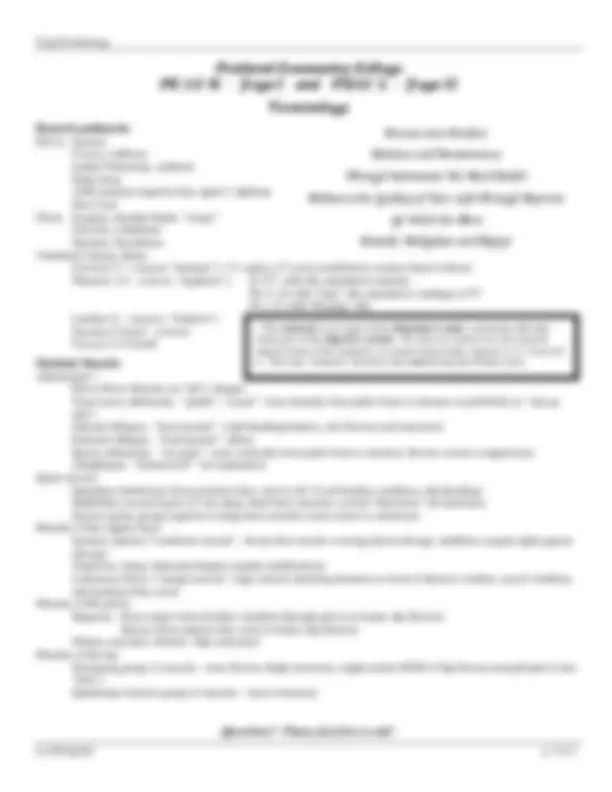



Study with the several resources on Docsity

Earn points by helping other students or get them with a premium plan


Prepare for your exams
Study with the several resources on Docsity

Earn points to download
Earn points by helping other students or get them with a premium plan
Community
Ask the community for help and clear up your study doubts
Discover the best universities in your country according to Docsity users
Free resources
Download our free guides on studying techniques, anxiety management strategies, and thesis advice from Docsity tutors
Material Type: Notes; Class: Yoga I; Subject: Physical Education; University: Portland Community College; Term: Fall 2009;
Typology: Study notes
1 / 2

This page cannot be seen from the preview
Don't miss anything!


Classical Hatha Anusara Ashtanga Bikram Iyengar Kundalini Sivananda Viniyoga Vinyasa Power Yoga Yin
used as universal principles of alignment
Skull loop
Shoulder loop
Kidney loop
Pelvic loop
Thigh loop
Shin loop
Ankle loop
Anjali mudra (Salutation) Viparita Namasté (Reversed Salutation) Dhyana mudra (Palm up in Palm up) Jnana mudra (thumb & first finger touching) Padma mudra (Blossoming Lotus)
1.1. Atha Yoganusasanam (now, in this auspicious moment, the sacred art of teaching Yoga begins)
1.2. Yogas citta vrtti nirodhah (yoga is the restraint of the modifications of the mindstuff)
Breathing Pranayama, Ujjayi, Nadi Shodhana Mantra normal (baikhari), whispered (upanshu), silent (manasik) Bandhas Mula Bandha, Uddhiyana Bandha The powerhouse “core” muscles Control Enter - Hold - Exit the Asana Precision Alignment in Asana - Anusara Posture Loops Energy Lines oppositional direction of effort/muscle wrap Drishti Direction of Gaze Vinyasa Flow/Fluidity of Movement, Transitions
Standing (also: “upside down”) Seated (also: balanced on sitbones) Kneeling (on all fours), or Kneeling Upright Prone (also: front support, elbow support) Supine (also: back support, elbow support) Side-lying (also: side support, elbow support) Balances (on single leg, arm balances) Inversion (legs above heart)
Spine: flexion (“forward bend”), extension (“backbend”), rotation (“twist”), lateral flexion (“side bend”) Pelvis: neutral, tuck, tilt Hip: (thigh bone in socket) - flexion, extension, abduction, adduction, inward and outward rotation Shoulder: (stabilization of shoulder blades with movement of arm): extension, flexion, abduction, adduction, rotation of humerus (mobilization of shoulder blades with or without movement of the arm): elevation, depression, protraction (abduction), retraction (adduction), rotation of scapula
YogaTerminology
Lia Kidoguchi p. 2 of 2
Pelvis: Sacrum Coccyx, tailbone Ischial Tuberosity, sitzbone Pubic bone ASIS (anterior superior iliac spine^1 ), hipbone Iliac Crest Chest: Scapula, shoulder blade, “wings” Clavicle, collarbone Sternum, breastbone Vertebral Column, Spine: Cervical (7 – concave “lordosis”), C1 (atlas), C2 (axis) modified to connect head to thorax Thoracic (12 – convex, “kyphosis”), T1-T7, with ribs attached to sternum T8, 9, 10 with “false” ribs attached to cartilage of T T11, 12 with “floating” ribs Lumbar (5 - concave, “lordosis”) Sacrum (5 fused – convex) Coccyx (3-4 fused)
Abdominals*: Pelvic Floor Muscles (to “lift”), Kegels Transversus abdominis, “girdle”, “corset” (runs laterally from pubic bone to sternum, to pull belly in, “zip up ribs”) Internal obliques, “back pocket” (side bending/rotation, also flexion and extension) External obliques, “front pocket” (ditto) Rectus abdominis, “six pack” (runs vertically from pubic bone to sternum, flexion, assists compression) (Diaphragm, “domed roof” for respiration) Spine movers: Quadratus lumborum (from posterior iliac crest to rib 12 and lumbar vertebrae, side bending) Multifidus (several layers of very deep, short back muscles, several “directions” all functions) Erector spinae group (superior to deep back muscles) main action is extension) Muscles of the (upper) back: Serratus anterior (“sandwich muscle”, broad, thin muscle covering lateral ribcage, stabilizes scapula tight against ribcage) Trapezius, (large, diamond-shaped, scapula mobilization) Latissimus Dorsi, (“armpit muscle”, large muscle attaching humerus to lower 6 thoracic, lumbar, sacral vertebrae, and posterior iliac crest) Muscles of the pelvis: Iliopsoas: Psoas major (from lumbar vertebrae through pelvis to femur, hip flexion) Iliacus (from anterior iliac crest to femur, hip flexion) Gluteus maximus, buttock (hip extension) Muscles of the leg: Hamstring group (3 muscles - knee flexion, thigh extension, might restrict ROM of hip flexion and pull pelvis into “tuck”) Quadriceps femoris group (4 muscles – knee extension)